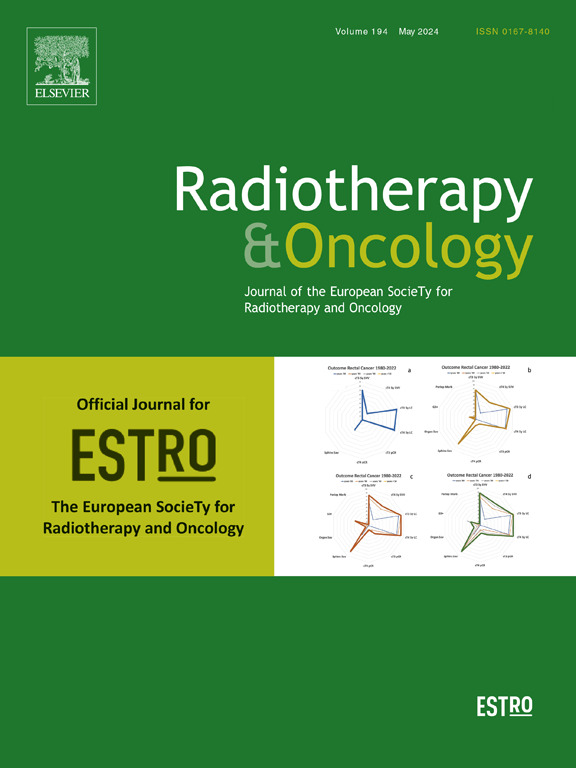Clinical outcomes of proton beam therapy for inoperable stage I-IIA non-small cell lung cancer: Japanese nationwide registry study
IF 4.9
1区 医学
Q1 ONCOLOGY
引用次数: 0
Abstract
Purpose
Radiotherapy is the standard treatment for unresectable stage I-IIA non-small cell lung cancer (NSCLC). One treatment option within radiotherapy is proton beam therapy (PBT). Currently, a prospective observational study is being conducted at all proton therapy centers in Japan as part of a proton beam all-case registry. This study aimed to evaluate the outcomes of PBT for inoperable stage I-IIA NSCLC.
Methods
We included patients with stage I-IIA (UICC 8th) NSCLC who had started PBT between May 2016 and June 2020. Overall survival (OS), progression-free survival (PFS), cumulative incidence of local failure (LF), and adverse events were evaluated. Prognostic factors were compared using log-rank test and Cox proportional hazards model. The cumulative incidence curves were compared using Gray’s test.
Results
A total of 309 patients were evaluated. The median follow-up period was 47 months, calculated using the reverse Kaplan–Meier method. The 3/5-year OS was 62.7 %/47.7 %, PFS was 52.9 %/40.0 %, and LF was 14.4 %/22.1 %. According to the stage, 3-year OS, PFS, and LF were 69.6 %, 58.7 %, 13.3 %, respectively, for stage IA; 55.3 %, 41.6 %, 15.6 %, respectively, for stage IB; 33.9 %, 41.5 %, 25.6 %, respectively, for stage IIA. Female sex and good performance status, absence of interstitial pneumonia, absence of double cancer, and T1 stage were favorable prognostic factors for OS in a multivariate analysis. Grade ≥ 4 adverse events were not observed.
Conclusion
This study provided real-world treatment outcomes of PBT for inoperable stage I-IIA NSCLC in Japan.
质子束治疗不能手术的I-IIA期非小细胞肺癌的临床结果:日本全国登记研究
目的:放疗是不可切除的I-IIA期非小细胞肺癌(NSCLC)的标准治疗方法。放射治疗中的一种治疗选择是质子束治疗(PBT)。目前,一项前瞻性观察研究正在日本所有质子治疗中心进行,作为质子束全病例登记的一部分。本研究旨在评估PBT治疗无法手术的I-IIA期非小细胞肺癌的结果。方法:我们纳入了2016年5月至2020年6月期间开始PBT治疗的I-IIA期(UICC第8期)非小细胞肺癌患者。评估总生存期(OS)、无进展生存期(PFS)、局部衰竭累积发生率(LF)和不良事件。采用log-rank检验和Cox比例风险模型对预后因素进行比较。累积发生率曲线比较采用Gray检验。结果:共评估309例患者。中位随访期为47个月,采用反向Kaplan-Meier法计算。3/5-year OS 62.7 % / 47.7 %,PFS是52.9 % / 40.0 %,如果是14.4 % / 22.1 %。按分期分,IA期3年OS、PFS、LF分别为69.6 %、58.7 %、13.3 %;IB期分别为55.3% %、41.6 %、15.6 %;IIA期分别为33.9 %,41.5 %,25.6 %。多因素分析显示,女性、良好的运动状态、无间质性肺炎、无双癌、T1期为OS的有利预后因素。分级 ≥ 4级未观察到不良事件。结论:本研究提供了PBT治疗日本无法手术的I-IIA期NSCLC的真实治疗结果。
本文章由计算机程序翻译,如有差异,请以英文原文为准。
求助全文
约1分钟内获得全文
求助全文
来源期刊

Radiotherapy and Oncology
医学-核医学
CiteScore
10.30
自引率
10.50%
发文量
2445
审稿时长
45 days
期刊介绍:
Radiotherapy and Oncology publishes papers describing original research as well as review articles. It covers areas of interest relating to radiation oncology. This includes: clinical radiotherapy, combined modality treatment, translational studies, epidemiological outcomes, imaging, dosimetry, and radiation therapy planning, experimental work in radiobiology, chemobiology, hyperthermia and tumour biology, as well as data science in radiation oncology and physics aspects relevant to oncology.Papers on more general aspects of interest to the radiation oncologist including chemotherapy, surgery and immunology are also published.
 求助内容:
求助内容: 应助结果提醒方式:
应助结果提醒方式:


